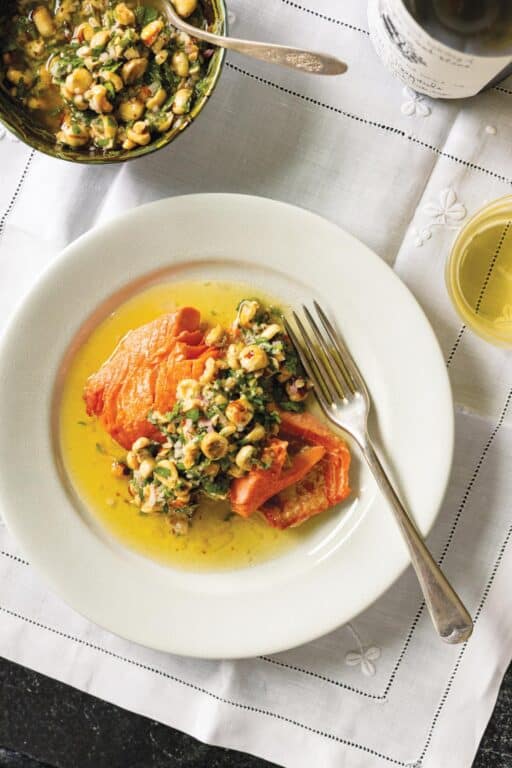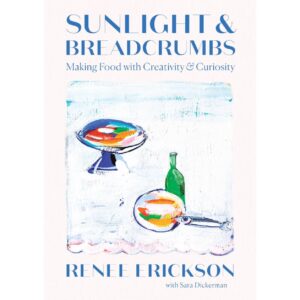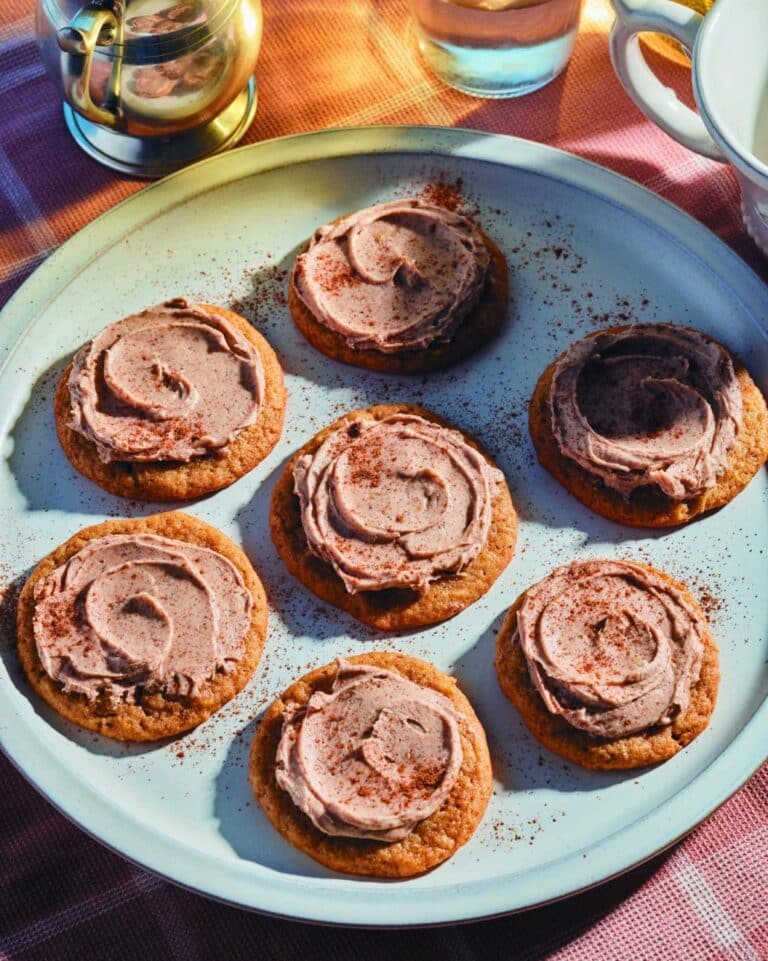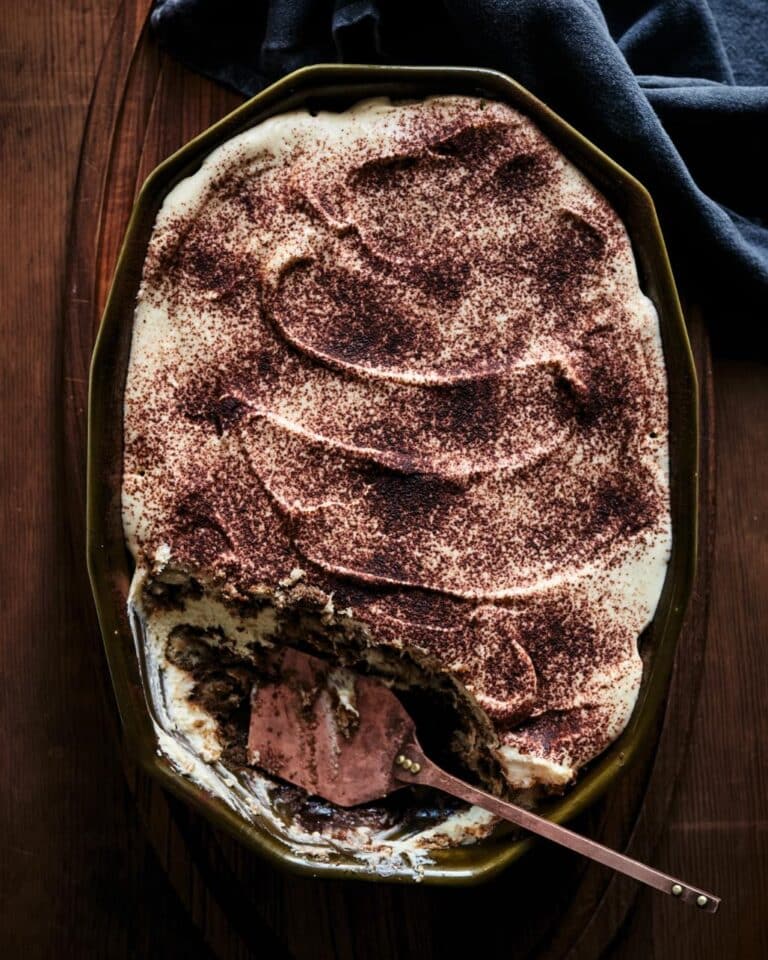
Salmon choices matter. If we manage things correctly, gorgeous Bristol Bay sockeye will be around for a lot longer. I wish we could say that for so many of the other salmon runs in the Northwest. Salmon is in trouble, and farmed salmon is gross (flabby in taste, and it pollutes the ocean). If you run into me sometime, I will let you know all the ways that farming is the wrong way to bring more salmon to the market. I will also encourage you to consider eating frozen fish, which allows you to be picky about the salmon you eat because you can order directly from well-managed fisheries—like the fish from Eva’s Wild, which can be shipped around the country to you! Frozen at sea, the quality of good frozen fish is often better than the “fresh” (usually thawed anyway) at the local market. – Chef Renee Erickson
Ingredients:
- 6 ounces (170 g) hazelnuts (Washington-grown Holmquist hazelnuts come dry-roasted and are fantastic)
- ½ cup (65 g) minced shallot
- 1 cup (60 g) Italian parsley leaves
- 2 tablespoons red wine vinegar
- 1 cup (240 ml) hazelnut oil
- 2 teaspoons Dijon mustard
- 2 teaspoons salt, plus more as needed
- Grated zest of 1 lemon
- 1 tablespoon lemon juice, plus more as needed
- 2 pounds (910 g) center-cut sockeye salmon fillet, skin on (see note on pinbones below)
- 3 tablespoons olive oil
Instructions:
Preheat the oven to 350°F (175°C).
Place the hazelnuts on a rimmed sheet pan and toast, tossing occasionally, until pale golden brown at their centers, 6 to 8 minutes. Let cool. Place in a mortar and pestle and crush them: Big pieces are OK, but make sure there aren’t any whole nuts. (This should be chunkier than if done in a food processor.) If you don’t have a mortar and pestle, you can put the nuts in a bag and smash them with a rolling pin or wooden mallet.
Soak the shallots in cold water for 5 minutes. Drain well, pressing with a folded paper towel to blot up the moisture. In a medium bowl, mix the crushed hazelnuts, parsley, shallot, vinegar, hazelnut oil, mustard, 1 teaspoon of the salt, the lemon zest, and lemon juice. Stir well and adjust the seasoning with more salt and lemon juice if desired. This can be stored in the refrigerator for a few hours or even overnight. Make sure there is enough oil to cover the chunks.
With a sharp knife, lightly score the skin side of the salmon fillet—about 6 crisscross incisions on the fatter side of the fillet. Season the fish with the remaining 1 teaspoon salt.
In a large (12-inch/30 cm) skillet, heat the olive oil over high heat until it shimmers. Place the fish in the pan flesh side down and shake the pan a bit to keep the fillets from adhering to the pan. Turn the heat down to medium and cook until the fish turns opaque about two-thirds of the way up the cut ends, about 3 minutes. Be careful, as the oil may pop and spit. Using a large fish spatula, carefully turn over the fillets. Turn the heat back up to high and shake again for about 30 seconds. Baste the skin with the accumulated juices. Turn the heat down, cover with a lid, and cook for 2 more minutes. Poke at the highest part of the fillet. If it flakes, it is done. If not, cover and cook for a bit longer. When done, remove the fillet to a plate.
Taste the hazelnut sauce and adjust with more salt or lemon juice if desired. With your hands, break the salmon into chunks and place it on serving plates. Stir the hazelnut sauce and spoon it generously on each portion. Serve with additional sauce on the side.
Note: Feel along the ridge of the fillet about two-thirds of the way from the tail; you’ll feel a gentle poke from a line of flexible bones called pinbones; you can pull them out with a pair of (clean) tweezers. Find a bone with your finger, pinch it with your tweezers, and pull toward the wide end of the fish. Repeat until you’ve got them all!
Work in Progress: Tap into Memories
I understand that not everyone feels nostalgic for salmon. If you grew up landlocked, it’s likely that the seaborn fish you ate wasn’t as signally fresh and pink and plump as the ones my dad and our neighbors caught midsummer. The seas have changed since I was a kid, and I don’t serve the most endangered species of salmon in my restaurants, but I still adore cooking and eating coho, sockeye, and pink salmon—it takes me back to the wonderful wilder moments of my childhood (that’s why I provide two salmon recipes in this chapter). For you, nostalgia might taste different: peach pie, fried chicken, or a hearty stew. But don’t give up on chasing those flavors of your youth: They offer powerful motivation in the kitchen. – Chef Renee Erickson
“Reprinted from Sunlight & Breadcrumbs: Making Food with Creativity & Curiosity by Renee Erickson with Sara Dickerman. Photographs © 2024 by Renee Erickson. Published by Abrams.”





